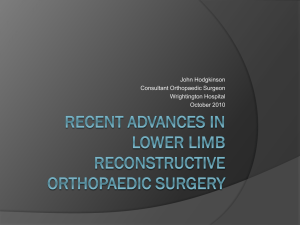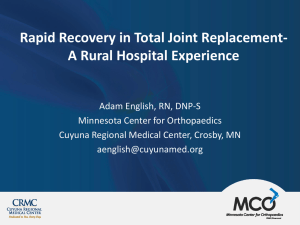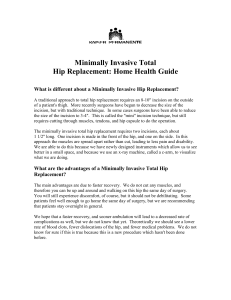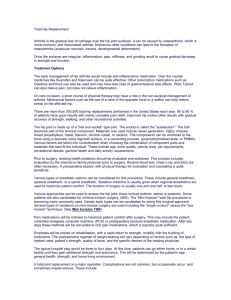Hip/Knee
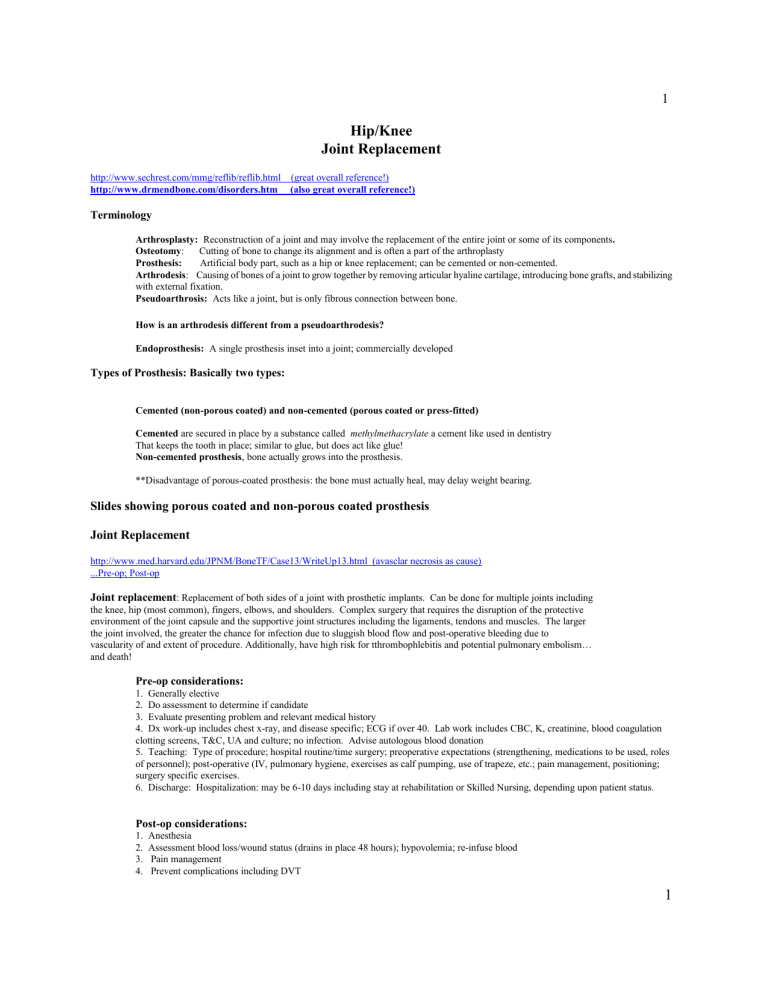
1
Hip/Knee
Joint Replacement
http://www.sechrest.com/mmg/reflib/reflib.html (great overall reference!) http://www.drmendbone.com/disorders.htm (also great overall reference!)
Terminology
Arthrosplasty: Reconstruction of a joint and may involve the replacement of the entire joint or some of its components .
Osteotomy : Cutting of bone to change its alignment and is often a part of the arthroplasty
Prosthesis: Artificial body part, such as a hip or knee replacement; can be cemented or non-cemented.
Arthrodesis : Causing of bones of a joint to grow together by removing articular hyaline cartilage, introducing bone grafts, and stabilizing with external fixation.
Pseudoarthrosis: Acts like a joint, but is only fibrous connection between bone.
How is an arthrodesis different from a pseudoarthrodesis?
Endoprosthesis: A single prosthesis inset into a joint; commercially developed
Types of Prosthesis: Basically two types:
Cemented (non-porous coated) and non-cemented (porous coated or press-fitted)
Cemented are secured in place by a substance called methylmethacrylate a cement like used in dentistry
That keeps the tooth in place; similar to glue, but does act like glue!
Non-cemented prosthesis , bone actually grows into the prosthesis.
**Disadvantage of porous-coated prosthesis: the bone must actually heal, may delay weight bearing.
Slides showing porous coated and non-porous coated prosthesis
Joint Replacement
http://www.med.harvard.edu/JPNM/BoneTF/Case13/WriteUp13.html (avasclar necrosis as cause)
...Pre-op; Post-op
Joint replacement : Replacement of both sides of a joint with prosthetic implants. Can be done for multiple joints including the knee, hip (most common), fingers, elbows, and shoulders. Complex surgery that requires the disruption of the protective environment of the joint capsule and the supportive joint structures including the ligaments, tendons and muscles. The larger the joint involved, the greater the chance for infection due to sluggish blood flow and post-operative bleeding due to vascularity of and extent of procedure. Additionally, have high risk for tthrombophlebitis and potential pulmonary embolism… and death!
Pre-op considerations:
1. Generally elective
2. Do assessment to determine if candidate
3. Evaluate presenting problem and relevant medical history
4. Dx work-up includes chest x-ray, and disease specific; ECG if over 40. Lab work includes CBC, K, creatinine, blood coagulation clotting screens, T&C, UA and culture; no infection. Advise autologous blood donation
5. Teaching: Type of procedure; hospital routine/time surgery; preoperative expectations (strengthening, medications to be used, roles of personnel); post-operative (IV, pulmonary hygiene, exercises as calf pumping, use of trapeze, etc.; pain management, positioning; surgery specific exercises.
6. Discharge: Hospitalization: may be 6-10 days including stay at rehabilitation or Skilled Nursing, depending upon patient status.
Post-op considerations:
1. Anesthesia
2. Assessment blood loss/wound status (drains in place 48 hours); hypovolemia; re-infuse blood
3. Pain management
4. Prevent complications including DVT
1
2
Rehabilitation
1. Exercises
2. Precautions: (metal detector)
3. Prevent infections (antibiotics for dental work)
Common Joint Replacement Surgery:
Fingers;
May replace small joints in fingers, primarily metacarpal; lenghly rehabilitation; use silastic materials. May be used for those with severe rheumatoid arthritis and can provide reduction in pain.
Shoulder: Surgery weakens and traumatizes the muscles and soft tissues and must heal before optimal results can be achieved. May take 6 months to one year for normal functioning and pain free. Used electively for individuals with painful degenerative rheumatoid or traumatic arthritis, or osteonecrosis of the glenohumeral joint. Will reduce pain and improve mobility of the shoulder joint, but requires a prolonged rehabilitation period. Remember that the shoulder is easily dislocated as it is supported only with muscle and soft tissue.
Shoulder: Pre/post-operative care
Pre-op involves the “usual”physical and emotional preparation for any joint replacement procedure
Post-op; period:
1. Pain management: use of PCA, cold, elevation
2. Neurovascular assessment (CMS checks)
3. CPM for shoulder mobility
4. Infection: Intravenous antibiotics prophylactically.
4. Passive stretching exercises start on the 4th post-operative day and continue for 6-8 weeks. Important for joint motion and the prevention of adhesion and include pendulum, pulley and resistive isometric exercises.
5. Active strengthening exercises begin 6-8 weeks after surgery, as other would cause soft tissue injury. Must strengthen the shoulder elevators, the rotator cuff. External rotators, extensors, and abductors.
6. Other concerns: Self care deficits, alterations in self-concept, and impaired home maintenance, and knowledge deficits regarding the rehabilitation process.
Elbow replacement: Similar care and concerns
*Clinical Pathways generally employed for elective surgery, especially hip and knee replacement.
*Infection a major concern following any joint replacement procedure.
Knee Replacement http://www.sechrest.com/mmg/tkr/index.html
(excellent source on total knee replacement) http://www.vh.org/Patients/IHB/Ortho/KneeReplace/KneeReplacement.html
(also excellent reference)
Knee replacement: A complex joint, not a simple hinged one. Generally stable. Vulnerable to injury and to arthritis. Over 300 types of prosthesis and some or all of the knee components may be replaced.
Slides showing knee anatomy: (Review structures of knee)
1.
articular cartilage
2.
diarthrotic joint
3.
ligaments to support including medial and collateral ligaments, and cruciate ligaments
4.
patella
5.
femoral and tibial condyles and meniscus
6.
Components for total knee replacement:
1.
femoral
2.
tibia
3.
patellar
Pre-operative includes practice of quadriceps, hamstrings, and gluteal setting exercises and post-operative. Also plantar and dorsiflexion and circumduction for venous return and straight leg raises. Transfer techniques, walking with walker, and strengthening of upper extremities. Pulmonary toilet. Overall improvement of nutritional status. Skin cleansing prior to surgery and no preexisting infections.
2
3
Post-operative includes: (Priorities = *)
Follow slides (2) to discuss priorities in post-operative care
1.
*CMS assessment
2.
*vital signs, post-operative bleeding
3.
Wound drainage, may be connected to wall suction, cell saver (recent event) and then reinfused to patient within 6-8 hours. Drainage must be kept open as premature clotting lead to a large hematoma, decreasing early ROM and breeding ground for bacteria. Drain kept in place for 24-48 hours. Must measure amount. Expect about 300 in first eight hours.
4.
CPM with leg elevation
5.
Pain management, IM or PCA
6.
Antibiotics prophylactically
7.
Ice bags for the edema
8.. Skin care (steroid dependent)
9. Pulmonary care
10. * Thrombophlebitis: Prevent by the exercises, CPM, and anticoagulation with ASA (not as effective in women), or coumadin postoperatively, and adequate hydration, TEDs hose (sequential compression hose), and assessments for Homan's sign, and measurement of calf and thigh.
11. Follow-up teaching and exercises.
Hip Arthroplasty/ Total Joint Replacement/Fracture
(Complete case study in study guide and discuss hip anatomy, blood supply to hip, recognition of hip fractures and assessment) http://www.sechrest.com/mmg/thr/index.html (excellent brochure on hip replacement) http://www.vh.org/Patients/IHB/Ortho/HipReplace/HipReplace.html (also excellent, comprehensive on hip replacement)
(1) How to assess for hip fractures
(2) The anatomy of the hip
(3) Why aseptic necrosis is the most frequent complication of hip fractures
(4) Difference between care of patient with ORIF of hip, those with prosthesis, and those with endoprosthesis and THR. Know about complications and how to prevent.
Critical Pathways work well for elective hip replacement surgeries
Hip Slides
1. Person fall, injuries
2. Hip anatomy
3. Blood supply: Joint capsule, ligamentous teres, lateral/medial circumflex artery. Identify types of fractures: intraarticular, intertrochanteric, and subtrochanteric and appearance and appearance of person with hip fracture.
4. Types hip fx: Subcapital, transcervical, intertochanteric, impacted.
*Priority nursing concerns:
Surgical approach and patient anatomy determine risk for potential hip dislocation in post-operative period and method to prevent!
Potential for infection post-op…antibiotics, sterile technique, teaching!
Know:
1. Type and amount of drainage to expect post-operatively for total joint (200 within 8 hours)
2. Exercises
3. Post-op teaching, i.e. not crossing legs, keeping legs abducted .
Note flexion and adduction favors dislocation; keep pillows between legs when side lying .
Amount of weight bearing permitted.
4. Difference of ORIF, prosthesis (porous coated or not), and total joint.
Case Study of Hip Fracture/Joint Replacement (cover in class!)
Initial Assessment for Hip fractures...factors to assess.... Priority... options
3
1. Initial assessment: Flexed, abducted, externally rotated, and shortened.
2.Compare Ms. James' fracture to other types.
Intracapsular fracture has poor blood supply
Extracapsular includes the intertrochanteric area and
has better chance to heal.
4
3.
Subtrochanteric fractures occurs with major trauma
Compare subcapital, transcervical, and basilar.
Nursing care problems/interventions pre-operative
Post-op Care...ORIF compared to Joint Replacement
Post-operative problems and actions
4. a. b.
Compression screw/nailing: Wheelchair with first 24-72 hours. Quad/gluteal sets. 3rd day do assisted ambulation and nonweight bearing 3-point gait. By 8-10 weeks do full weight bearing. 3-5 month according to text.
Endoprosthesis: Allows earlier weight bearing, as there is no bone to heal. Surgical approach makes the difference. How joint moved to dislocate, the same movement will dislocate the joint again. With total joint this is special problem. 6 weeks keep legs in abduction, neutral without internal rotation and adduction. Use abduction pillow, but alert to complications. Infections are c. major concern. Remove prosthesis and do arthrodesis.
Hemovac generally needed and use cell-saver.
THR is elective procedure.
4. Methylmethacrylate: Complications: Cause heat to be generated. Produce a pink tinged mucus in initial post-operative period. Porous coated prostheses allows for bony ingrowth and bone grows within the pores of the prosthesis to form interlocking bone and long lasting fixation.
This delays weight bearing. Must have sufficient bone, no infection, good vascularity, and no systemic disease.
5. Complications a. Compression screw: b. c. d.
Femoral head endoprosthesis
Total joint replacement:
35 to 60% DVT and emboli
6.
Discharge instructions...
Discharge teaching
Include complications with screw/nails; no dislocation precautions; weight bearing limited for first 3-5 months as bone must heal, exercises; and referral.
7. Teaching for patient with total hip: Exercises. Don't force hip into more than 90 flexion. No cross legs, put on own shoes until 6 weeks post surgery or sit on chairs without arms. Do use elevated toilet seat, keep pillow between legs at night, keep legs in neutral, lie prone once day, notify if pain, and do exercises.
4


